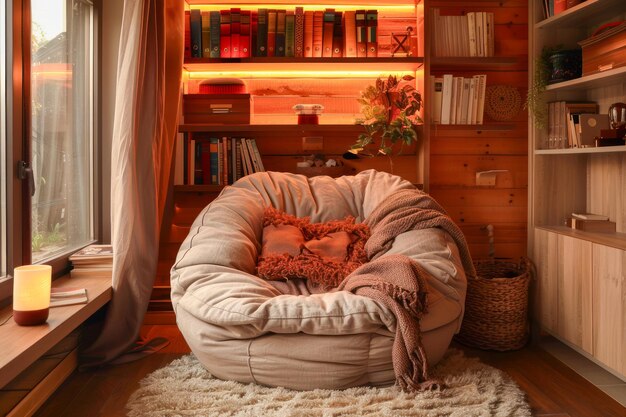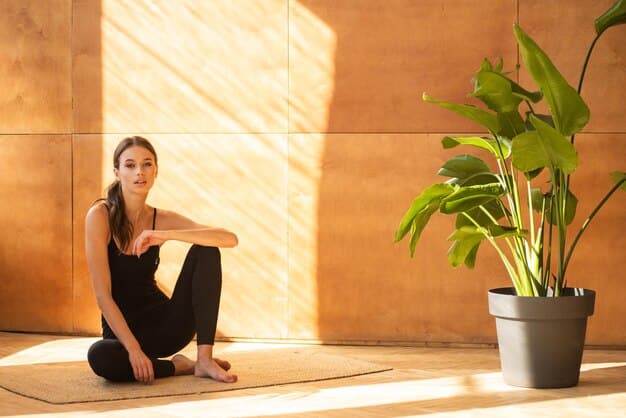Create Your Mom Sanctuary: Home Design for Self-Care in 2025

Creating a personal sanctuary at home is essential for a mom’s well-being; this guide provides tips and design ideas to transform any space into a relaxing retreat for self-care.
Being a mom is rewarding, but it’s also demanding. This Mom’s Guide to Creating a Sanctuary: Design a Relaxing Space in Your Home for Self-Care offers practical tips to carve out a personal haven where you can unwind and recharge.
Why Every Mom Needs a Personal Sanctuary
Moms often prioritize everyone else’s needs before their own. Creating a personal sanctuary isn’t selfish; it’s a necessary investment in your mental and physical health. Having a dedicated space for relaxation helps reduce stress and improve overall well-being.
A sanctuary provides a space where you can escape the chaos of daily life and focus on yourself. Here’s why it’s so important:
Reduces Stress
A calming environment helps lower cortisol levels, reducing stress and anxiety.
Improves Mental Clarity
A quiet space allows you to clear your mind and gain clarity.
Enhances Self-Care
Having a designated area encourages regular self-care practices.
- Prioritizing self-care prevents burnout.
- A sanctuary offers a physical reminder to take time for yourself.
- Improved mental health leads to better parenting.
Ultimately, a personal sanctuary is about creating a space that supports your well-being, enabling you to be the best version of yourself.
Finding the Perfect Space in Your Home
Your sanctuary doesn’t need to be an entire room. It could be a corner of your bedroom, a sunny spot in the living room, or even a small outdoor area. The key is to choose a space that feels peaceful and private.
Assessing your home will help you identify the best possible location. Consider these areas:
Unused Corners
Transform an empty corner into a cozy reading nook.
Spare Rooms
If you have a guest room, consider converting it into a multi-functional sanctuary.
Outdoor Spaces
A patio or balcony can become a tranquil outdoor retreat.

Once you’ve identified a few potential spaces, think about which one feels the most inviting and conducive to relaxation. Make sure it’s a place where you can easily escape without feeling guilty.
Setting the Mood: Colors, Lighting, and Scents
The ambiance of your sanctuary plays a crucial role in its effectiveness. Colors, lighting, and scents can all have a significant impact on your mood and relaxation. Choose elements that create a calming and inviting atmosphere.
Here’s how to incorporate these elements:
Choosing Calming Colors
Opt for soft, muted tones like blues, greens, and lavender.
Incorporating Soft Lighting
Use lamps with warm bulbs and avoid harsh overhead lighting.
Adding Relaxing Scents
Essential oils like lavender, chamomile, and eucalyptus can promote relaxation.
- Use candles, diffusers, or room sprays.
- Choose scents that evoke positive memories.
- Avoid overpowering fragrances that can be distracting.
Experiment with different combinations to find what works best for you. Remember, the goal is to create an environment that feels soothing and nurturing.
Comfort is Key: Furniture and Textiles
The furniture and textiles you choose for your sanctuary should prioritize comfort and relaxation. Opt for pieces that invite you to unwind and feel at ease. Think plush cushions, soft blankets, and supportive seating.
Consider these elements:
Comfortable Seating
A cozy armchair, a cushioned bench, or a hammock are all great options.
Soft Textiles
Add plush blankets, soft throw pillows, and a comfortable rug.
Personal Touches
Incorporate items that bring you joy, such as photos, artwork, or mementos.
Avoid clutter and keep the space simple and organized. A minimalist approach can help create a sense of calm and serenity.

Creating a Tech-Free Zone
In today’s digital world, it’s essential to disconnect from technology to truly relax. Designate your sanctuary as a tech-free zone where you can unplug and recharge. This means no phones, laptops, or televisions. Instead, focus on activities that promote relaxation and mindfulness.
Here are some ideas:
Reading
Keep a collection of your favorite books on hand.
Meditation
Create a meditation corner with a comfortable cushion and a calming atmosphere.
Journaling
Use a journal to reflect on your thoughts and feelings.
- Invest in a comfortable meditation cushion.
- Download guided meditation apps.
- Practice deep breathing exercises.
By eliminating digital distractions, you can fully immerse yourself in the present moment and experience a deeper sense of relaxation and rejuvenation.
Adding Personal Touches and Meaningful Elements
Your sanctuary should reflect your personality and interests. Add personal touches that make the space feel uniquely yours. This could include artwork, photographs, plants, or other items that bring you joy and inspiration.
Focus on elements that are meaningful to you:
Artwork
Choose pieces that inspire you and evoke positive emotions.
Photographs
Display photos of loved ones or favorite memories.
Plants
Incorporate greenery to create a sense of calm and connection to nature.
Personalizing your sanctuary makes it a true reflection of who you are and what you value, enhancing its power to promote relaxation and well-being.
Maintaining Your Sanctuary for Long-Term Well-Being
Creating a sanctuary is just the first step. To reap the long-term benefits, it’s essential to maintain the space and make it a regular part of your self-care routine. This means keeping it clean, organized, and free of clutter.
Follow these tips for maintaining your sanctuary:
Regular Cleaning
Dust, vacuum, and tidy up the space regularly.
Decluttering
Remove items that no longer serve you or bring you joy.
Consistent Use
Make time to use your sanctuary regularly, even if it’s just for a few minutes each day.
By making your sanctuary a priority, you can ensure that it remains a valuable resource for relaxation, stress reduction, and overall well-being.
| Key Point | Brief Description |
|---|---|
| 🏠 Creating the Space | Designate a quiet area in your home for your sanctuary. |
| 🧘 Relaxation Techniques | Incorporate relaxation techniques like meditation or deep breathing. |
| 🌿 Mood Enhancers | Add calming elements like soft lighting and soothing scents. |
| 📵 Tech-Free Time | Designate it as a tech-free zone to disconnect and recharge. |
FAQ
Having a personal sanctuary helps moms reduce stress, improve mental clarity, and prioritize self-care. It provides a space to recharge and focus on their well-being amidst daily demands.
A sanctuary can be created in any quiet space, such as an unused corner, spare room, or even an outdoor area like a patio. The location should feel peaceful and private.
Incorporate calming colors, soft lighting, and relaxing scents using candles, diffusers, or room sprays. Choose elements that evoke positive memories and create a soothing atmosphere.
Designate the area as a tech-free zone by avoiding phones, laptops, and televisions. Focus on activities such as reading, meditation, or journaling to fully disconnect and relax.
Maintain your sanctuary by keeping it clean, organized, and free of clutter. Regularly use the space, even for a few minutes each day, to ensure it remains a valuable resource for self-care.
Conclusion
Creating a personal sanctuary is a powerful way for moms to prioritize self-care and enhance their overall well-being. By designing a space that promotes relaxation, reduces stress, and reflects your unique personality, you can create a haven that supports your physical and mental health for years to come.





